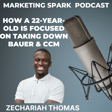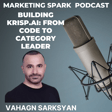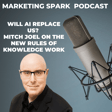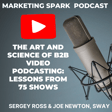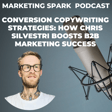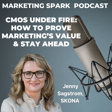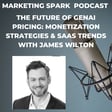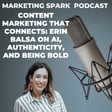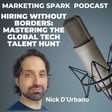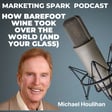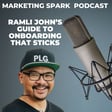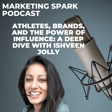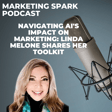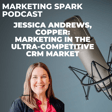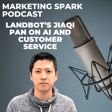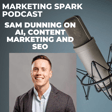Introduction to Personalization and Revenue Acceleration
00:00:09
Speaker
It's Mark Evans and you're listening to Marketing Spark. In this episode, I'm exploring the intersection of personalization, revenue acceleration, and standing out in a noisy digital
Brayden Young's Journey with Sendoso
00:00:21
Speaker
world. My guest is Brayden Young, the co-founder of Sendoso, a platform that transformed how companies connect with prospects and customers through direct mail and gifting.
00:00:30
Speaker
Over the past 10 years, Braden helped reshape how revenue teams operate, enabling more second calls and faster deal closes by making B2B outreach more personal, meaningful, and memorable.
Exploring Personalization at Scale
00:00:42
Speaker
Having recently stepped away from Sendoso, Braden is now diving into a new venture slash experts.
The Evolution of Sendoso from Coffee Sender
00:00:48
Speaker
Today we'll unpack how personalization at scale works, why it matters more than ever, and what Braden has learned from building Sendoso and now starting afresh with a brand new startup. Welcome to Marketing Spark.
00:00:59
Speaker
Thank you. It's good to be here. 10 years sounds like a really long time. but When I was writing that post on LinkedIn, I got a decade of direct mail. I think I've seen it all, maybe, at least from the B2B angle.
00:01:10
Speaker
Direct mail. Did you ever imagine that you'd spend 10 years Sendoso in the tech
Challenges and Growth through the Pandemic
00:01:16
Speaker
world? 10 years is a lifetime, especially for a co-founder. A decade must have flown by. A lot happened during that 10 years. A lot happened. A lot.
00:01:25
Speaker
We originally started Sendoso as a platform called Coffee Sender, so a way to send Starbucks gift cards. It was purely just a way to make side money, and it hit the account-based marketing world at the right time, and folks for coffee, gift cards, e-gift cards work.
00:01:41
Speaker
Can I also send physical things? We were at different jobs when we began it It was one of those things that I know. 10 years was through a pandemic. ah it was it was a big deal to step back and to try
The Inspiration and Rebranding of Sendoso
00:01:55
Speaker
to build something new. But now I have a lot of stories to share, a lot of learnings that I went through for 10 years. Let's take a step back and talk about when you and your co-founder decided to start Sendoso.
00:02:05
Speaker
What was the inspiration? What were you doing before? And what was it to take the leap into being an entrepreneur? So when we began, it we did the Starbucks gift cards. We had attached them to emails and we found a team to help us build it on the engineering side. We launched it. CoffeeCenter.com was a really cool side hustle. Then quickly it took off. People were like, this is a different way to reach out.
00:02:29
Speaker
The platforms outreach and sales lofts and we're just coming on the scene. Yesware was the big one at the time. And it was all about sending emails as fast as you possibly could at scale. We were trying to stand out by having a gift card attached saying, Hey, take my demo. Here's five bucks Starbucks.
00:02:44
Speaker
We quickly got asked to say more than just Starbucks gift cards. Folks were like, I want to send DoorDash. I want to send physical things. It was the East Coasters. I want to do Dunkin' Donuts. And we're like, okay. We got figure out how to get more into the platform and we can't call it just coffee
Integration and Differentiation Strategy
00:02:59
Speaker
center. We rebranded and we figured out how to add more e-gifts.
00:03:04
Speaker
We also figured out how to do a warehouse, which that was a million stories there. We met a guy at a bar who was like, I run a warehouse. And we're like, perfect. We'll send you stuff. That was in Vegas and learned how to do some warehousing. It was a quick turn in terms of trying to stand out. We hit it at the right time because account-based marketing was the big wave Everyone's I need to stand out. I need to have a different way to reach out.
00:03:26
Speaker
Emails at scale aren't working. And we' we're like, yeah, we do gifting. Everyone does it. No one tracks it. That was the big push. It was the right time. The question we would ask on calls was always, hey, do you do holiday gifting? We're like, yeah, I'd send all kinds of things during the holidays.
00:03:40
Speaker
Like, great. What was your ah ROI on it? And they were like, have no clue. So that was how we did our demos. I start for the first three years. I mean, it was the right time. And then we grew from there. We raised a little money and then a lot of money to build out a big network of warehouses and to build a way to do gifts for B2B companies.
Identifying Success Signals and Rapid Development
00:03:57
Speaker
I do want to talk about raising money in total through a Series C. $160-ish. $160-ish. $10 million here or there. Yeah, $10 million here or there. Set me back a little bit. Direct mail and gifting weren't new when Sendoso appeared on the scene.
00:04:13
Speaker
Why did you think there was an opportunity and what made Sendoso's approach feel fresh and effective in the B2B space? There was one company that was around that was doing it. and They'd been around for a while and that was the only one that we saw that where you could log into a Salesforce and do a GIF directly from a contact page. Our biggest mode at the time was everyone wanted to be a platform of record. We don't want to be a platform record. We just want to plug into the tools where you already are.
00:04:40
Speaker
So we took the Sendoso tool and plugged it into Salesforce, Outreach, Sales Loft, SurveyMonkey. You could do gifting directly from those platforms, this Chrome widget that helped us plug in.
00:04:50
Speaker
And that was the difference, was people didn't have to go log in to another location. It was like you could gift directly from your Salesforce page, which was huge. Because so at the time, everyone wanted to have a platform you logged into, because everyone wanted that data.
00:05:03
Speaker
And we went the different approach, which helped us. but originally started doing Amazon gift cards. You meet a guy in Vegas who says he has a warehouse and every entrepreneur who's optimistic about the future, you jump on that.
00:05:19
Speaker
When did you know the idea was going to turn into real traction? It's a signal that some entrepreneurs get, some entrepreneurs miss it, some entrepreneurs never
Raising External Funding and Investor Involvement
00:05:27
Speaker
see the signal. At what point did you realize we've got a tiger by the tail here and we didn't need to execute properly?
00:05:34
Speaker
I think there was four real signals. One, when we originally started, we only wanted to own the digital side. The one company that did a lot of the physical sending didn't want to partner with us because they were concerned what you're building. They don't want anyone else in their space. That was an interesting one. I think we're chasing the right thing.
00:05:50
Speaker
The next one was when we launched Coffee Sender, just a way to do e-gifts, we did $60,000 revenue the first month. This was a side project and we were, granted margins were 1%. were like, wow, this is a lot of people having hunger for sending gifts to people to try to stand out from all the emails they get.
00:06:06
Speaker
The third one was when we started building, Probably the biggest one. We started building, we started selling. I was the only one selling. Chris was my CSM slash CEO. So I was selling deal, go to Chris, we'd onboard them and go back and forth. and very early, we had an inbound lead from Capital One and they were, we're in, we need to do this. if My desk has all this stuff underneath it. I need to be able to use you. That was a really big surprise that an enterprise company wanted to leverage us and use us that soon.
00:06:33
Speaker
in the sales cycle. We didn't close them until years later, but it meant that we could land meetings with really big companies. That was one of those things where i was like, okay, I think we've hit a really big pain point in the market is that people want to send gifts out, but they don't know how to do it and they don't know how to track it. That was one of the biggest ones, I would say.
00:06:51
Speaker
The last one, as I knew would work, is once a deal closed that i wasn't involved in. A deal comes in Salesforce and it closes and you're like, wow, wow. Okay. I think that was a big deal. Then they renewed. That was probably like the biggest two-year cycle. Once you see that happens, this is actually something that can scale.
00:07:07
Speaker
For most startups, product development, job one. Sales is job two. Then they get around to marketing. What was the Sandoso recipe to sales and marketing? A lot of companies, great product, right time, great place, but they can't get the word out to attract the people that matter to them.
00:07:27
Speaker
Ours was probably different than most startups are out there. My background is sales. Chris's background is sales. We sold a ton of the product before it really worked properly. Most entrepreneurs, i would say, build a beautiful product and then they're great. The market's going to love this. And then they out and sell it.
00:07:43
Speaker
We were, lack of a better phrase, we were flying the airplane and building at the same time. of those things that we brought on a lot of companies who were like, yeah, i need this. This is great. Do you guys have this component? We were like absolutely. We didn't. was one of those things where we needed to go figure out engineering, how to build this thing. We wouldn't build integrations until someone was like, hey, do you plug into X tool?
00:08:01
Speaker
Absolutely. Where it's actually on the roadmap. And then you'd have two weeks to build it and then you'd launch it. We were building as quickly as we could to keep up with sales, which is the opposite of, I would say, most companies.
00:08:12
Speaker
That made it weird with raising because when you're typically two salespeople, they want to know who your technical co-founder is. We didn't have one. We got really good at wire framing, got really good at learning what engineering was doing, which was all abroad.
00:08:24
Speaker
But we had couple million sales in the first year, which helped us get past the hurdle of, where's your technical co-founder?
00:08:33
Speaker
As the business is growing and as your financial needs increase, at what point in time did you realize that you had to raise external funding? to Friends and family is a root that many entrepreneurs embrace because it's easy and you don't have to put yourself out there in a big way because you have relationships with people.
00:08:53
Speaker
But at some point, you have to raise that C round and have to raise the A round. How did that process work at Sendosa? Who led it? What advice would you offer other entrepreneurs who are looking to go down that path?
00:09:04
Speaker
It's one that you have to, it's really a muscle you have to practice. We started pitching VCs day one. Here's what we're building. We were looking for more feedback and we weren't raising money. Just say it was like, we're building. What do you guys think? We got a lot of really harsh feedback. The founder calling your baby ugly thing. I don't know what they're talking if You learn that early on that the feedback is good and take, you get a lot of it. but you take the ones that you know you really feel are important to you.
00:09:27
Speaker
We started pitching really early and then as we started growing, we ended up being, like we need more money to grow faster because we had enough demos to keep us really busy. We had enough and we knew companies were sending using the platform. We just need more companies to help use us. We wanted to go to conferences. Conferences are really expensive.
00:09:43
Speaker
had to raise. So we did our series seed through fund called Storm Ventures and Storm Ventures did Marketo and Engageo. They knew the marketing space really well. They helped us get into a ton of early companies that were in the marketing space to help to scale.
00:09:57
Speaker
that's important too is know whoever you raise from if they're in the space you want to grow in where your acp is that's who you want to raise from they helped a ton and then we started growing even faster we thought probably the whole time that we were always going to raise we wanted to shoot ah as high as we could because it was our first startup our a was through k craft ventures that helped us more on the side around growing in small s&b clients trying to figure out what the tech space was a more david sacks and brian murray helped us a ton in their days figure out the fundamentals of the company their backgrounds all the benefits to those types of companies Then we did Oak Ventures for our next round. That was growing international.
00:10:31
Speaker
Then we took a big check from
Challenges of Large Investments and Maintaining Culture
00:10:32
Speaker
SoftBank. Everyone reads about that in the TechCrunch world. the SoftBank goes, like here's money, burn it, grow as fast as you can. After that check, you quickly learn, okay, let's how far we can take this.
00:10:43
Speaker
That was in the middle of the pandemic. I'm sure as everyone read about it a million times in TechCrunch, everyone all of a sudden was like, now you got to be profitable. You can't burn it anymore. That was the big change. We learned a ton as to how to grow as fast as possible overnight to then turn around its head and say, hey, grow responsibly.
00:10:58
Speaker
That was a big shift, but we learned how to scale after that. right The question that I always have to ask entrepreneurs who raise a lot of money is when someone writes you $100 million dollar check,
00:11:10
Speaker
It says grow as fast as possible. What does that feel like? after you Crazy. Raising the money. And then once you've closed the deal, you've got investors who are expecting not only big things, but massive things. And they want it to happen really fast.
00:11:25
Speaker
What does that feel like? How do you figure out where to spend your money, how to spend your money and make sure you're doing it in the right ways at the right time? It must be overwhelming. It's exciting. The day you get a wire into the bank. This is serious. Let's make this thing happen. then We had an amazing executive team. We were simultaneously growing internationally as fast as we could in APAC and in EMEA.
00:11:46
Speaker
In the US, we had to grow as well. We were hiring probably 60 people a month. And it was very fast growth. The problem is that you're almost growing so fast that you can't keep up with the growth or who's even being hired.
00:11:58
Speaker
And it was by the market. It was like do you have competition? Undercut them for three months. If their price is usually ten k say zero and just buy other customers. It was almost like the model of Uber and Lyft when it was like, hey, just buy as many users as you possibly can and then monetize later. That was the mantra. And it worked for a lot of companies. The problem was they could all turn on its head when the market changed.
00:12:20
Speaker
But you'd onboard 10, 20 customers in the morning, another 10, 20 in the afternoon. it was very fast. And warehousing was, of course, we have a physical side of our product. So we tripled that over a period of a couple of months.
00:12:32
Speaker
That was pretty hard to hang on to. And it was cool to see grow. You have to have a meticulous project management skills. Get an entire team here that's helped us with the project management of keeping like the projects in line.
00:12:44
Speaker
So it was a lot of fun. I think that if the market wouldn't have changed, would we have kept growing? Probably. I think the question would be, would be profitable this point? probably not I'm not sure whether you're a culture, mission, vision kind of entrepreneur.
00:12:57
Speaker
Curious about what it was like when you're going that fast to maintain the corporate culture, to make sure everyone's on the same page and feel like you as the leader have a connection with your employees.
00:13:08
Speaker
As you grow globally, we also had COVID in the middle of it too. Also everyone was at home. It was values, mission, having all hands once a week became incredibly important. I think what you run into from a very small scale. So we did Francisco is where we started where I am. And then we did a sales office in Scottsdale, Arizona. Even that small distance, we had a very different culture in both offices.
00:13:30
Speaker
And we learned that very early since 2018, 2019. So I spent my weeks in Arizona, I'd go back and forth, which was also before kids. It was very easy to get around. was one of those things where I could spend time there and try to blend the two offices lot, which helps, going back and forth a ton, having an open door policy.
00:13:46
Speaker
As we started growing even faster, we had an office in Europe. We had an office in Pakistan. You had these very different cultures across all the offices, which doesn't work. Because when you hop on, when you have values and mission, it's great. But I think they're just words at that point. You have to have your leaders actually living those values and showing you in person living those values. It became how can we be in all the offices at one time?
00:14:06
Speaker
Then COVID changed a lot of that. I think you can have fun culture things, but it comes down to like transparency as value. You need to be transparent on the all hands. so Those are things that can be lost in the shuffle of raising that much money. It's easy.
00:14:19
Speaker
to get those things lost. I would say we went through times where we weren't great about values. And we realized that because we did a ton of EMPS scores and employees would be like, i need to know what's going on. What are we working towards? Those are important things that we had to put in
Brayden's Transition from Sendoso to New Ventures
00:14:30
Speaker
We got there. It was rocky though, as we were hiring 60 people a month and boarding was different in Pakistan versus Ireland versus Scottsdale. And then everyone was remote at one point.
00:14:43
Speaker
So it took a lot of figuring things out for sure. want to move on to some other topics, but do want to talk about your stepping back from Sendoso.
00:14:54
Speaker
This has been 10 years of your life. You're vested personally and financially. When did you realize that your role had shifted at Sendoso?
00:15:04
Speaker
And ultimately, when did you decide to step back? if You were an advisor for a while, and now you're on board. Was there a moment in when you realized that it was time for someone else to...
00:15:16
Speaker
Be there and you had to step back and do other things. I think every entrepreneur that listens to your show will take the note I'm talking about. I was in the meeting and going over a topic and i texted Chris, my co-founder.
00:15:28
Speaker
And I was like, I've been in this meeting five times. We've had this conversation five times. It became where i started saying things like we tried this in the past eight years ago. Here's what happened. Here's why we shouldn't do that. Once you start going through that, you learn I'm not giving everything I can to this company because I'm shutting down ideas that we tried it years ago. and I shouldn't be doing that.
00:15:47
Speaker
I went and worked on ah Macintosh project for a while at Sendosa, which was great. Built a really cool team, a really cool PLG product, launched that, which is awesome. Then I started looking for my next project probably a year ago.
00:15:59
Speaker
We had a challenge internally at Sendosa with converting web traffic. And we're like, how do we convert this web traffic? We have a ton of it. And not everyone's taking a demo. So how can I give them another path take? That's where the idea of the experts came from, where you can actually connect to customers as a prospect.
00:16:17
Speaker
and do a conversation that way rather than talk to sales. Cause people trust that third party more. They want to have the back channel more transparent. That was a top of funnel solve. And what if we also apply this to sales? Sales can make referrals easier and use that throughout the sales cycle.
00:16:30
Speaker
That was the light bulb moment again, like early on. So I started pitching it and growing it a little bit ago, it jumped and started to build out this new motion to change the way a sales pipeline is built.
00:16:41
Speaker
Rather than talk to sales. Was that the first itch you had while you were at Sendoso along the line where there's any other things you were looking at or is this the big one? I think this was the big one. You'll see on LinkedIn, a lot of founders put advisor on their LinkedIn profile because they're talking to founders who are just starting. Many of us do that because we miss the early days of the chaos of the early days. it helped scratch that itch for a while.
00:17:03
Speaker
And at some point you're like, I'm ready to go do it again. There was a lot of success at Sendoso. A lot of it comes with like a personal life too. My kid's now three and I have some more time to go work on something. like She's a school. It all matches out to when it was the right time to jump, which was
Introduction to Slash Experts and New Sales Approach
00:17:16
Speaker
which was experts. I'm excited to build this out. It was lot of conversations with my spouse saying, I think I'm going try this again.
00:17:22
Speaker
Let's see where it goes.
00:17:27
Speaker
Let's talk about SlashExport. You had a thesis and hypothesis. You've raised some money, which is awesome. I guess that's the benefit of being a successful entrepreneur. People take a leap of faith with you because you've been successful. What is SlashExport? What is the problem that you're trying to solve and who's your target audience?
00:17:42
Speaker
ICP is the same. I've sold the marketing for a long time, marketing and sales. So when you go to most websites like Sendoso.com and your only path is a demo, what if we had a path where you actually have a directory of customers you can connect to and like Sendoso.com slash experts, hence the name. On that experts page, you have a bunch of people that are on there that are customers, they love Sendoso and you can book a time with them directly.
00:18:02
Speaker
rather than talk to sales. The goal there is what we saw was most people, when they're looking at a new software, a new tool, they go to their communities, peers, and they ask, hey, is anyone using this tool?
00:18:13
Speaker
The answers they get, they decide to take a demo or not. We want to be able to capture that on the front end and be like, hey, you can actually book a time directly with the customer on that page. That's top of funnel on the backend. If you're a customer and you do a phone call, we gift you saying, hey, thanks so much for doing the phone call. So it's a gifting component. Also here's the AI piece.
00:18:32
Speaker
All those phone calls essentially can get transcribed and fed back into your CRM. So you can start looking for patterns as to which ways and how you should change content. how you should market to your customers and prospects because you're actually gonna get an in-depth version of that phone call, which is really cool. So that data is really important.
00:18:49
Speaker
If you take GLG or Tegis or AlphaSites and apply it to B2B is our hypothesis. So wanna get deeper into that, but I do wanna take a step back and talk about the problem with book a demo, see a demo, talk to an expert.
00:19:02
Speaker
Every B2B SaaS company, at least the vast majority of them, embrace this technique. This is the default call to action. there's All they want to do is get someone to talk to them, have a conversation, get them into the funnel.
00:19:16
Speaker
From your perspective, from all the traffic you saw at Sendos, what's wrong with Book a Demo? Is there Book a Demo fatigue happening? Is buyer behavior changing? You're trying to put forward an alternative to Book a Demo. What is the problem with Book a Demo?
00:19:31
Speaker
I think the typical problem is incentives are off. The people that are trying to get you to go to a website and to Book a Demo is marketing. They want those MQLs. They want to people to say, hey, here's the pipeline we pass on to sales. So you become almost like, hey, lu we passed on ABC company. They're now talking to sales. Marketing is like great. See, we did our job. We built pipeline.
00:19:48
Speaker
Then they go to sales and youre hop on the phone with somebody who maybe hasn't done the best job of understanding who you are as a company, but almost becomes a motion of shoving product down your throat. Or, hey, here's why you should use us. And the best sales reps are the ones that are like, hey, maybe we're not a fit for you, which is good. I think that it's a good thing as a sales rep, but I think sometimes managers don't understand that.
00:20:06
Speaker
And then all of a sudden you're in the sales cycle. They've basically Franken signed this product to fit for your need. Then you buy it and then you go to CX who basically has to figure out what you bought and then it might work and might not work and then maybe you churn in a year or it becomes shelfware.
00:20:18
Speaker
That process doesn't work. What most folks have been to solve it is they go to their networks and peers and they ask, hey, does anyone use this tool? Has it worked? That works a ton because, but the problem is the marketers that are adding that book a demo button don't know what they're saying in there. but They're trying to figure out how they can make the product better. I think that you're helping solve some of that by actually having conversations and having, and knowing what your peers are talking about.
00:20:39
Speaker
A way that companies have solved this is there's the PLG mode. Okay, just sign up and use it and come and see it. And which is great because you can actually see the product now. But the problem is there's still that upsell motion. You're still getting pinged all the time. Hey, you should talk to us so we can show you what you're in.
00:20:53
Speaker
Both sides are a fail. The only real outcome is to talk to folks who have used that tool. or to maybe go read reviews on all the review sites, but do you actually trust those?
Customer Involvement and Engagement in Slash Experts
00:21:03
Speaker
It's a real mess, I would say, as I get educated about new software. So our solve is to make it where there's people we can go and talk to.
00:21:09
Speaker
They're incentivized to join the phone call and they could tell you you're not. It's more, here's why we use it. Here is our problem. I'm the same title as you. We can help match people. I think that's going to be a big motion in B2B.
00:21:21
Speaker
It's a really interesting concept, but I would push back and this is me being the glass half empty person. Listen, as a marketer, I have a really hard time trying to get customers to even give me a testimonial, let alone a case study.
00:21:34
Speaker
You're asking customers to open their calendars so that random prospects can call them and ask them about their opinion about software. You're taking some of their time.
00:21:47
Speaker
They're doing you a big favor by acting as an expert or a reference. So how do you make it look like a win-win? The prospect gets what they need, the company gets what they need, and the customer is rewarded for their efforts. How big of an incentive do you have to give them to make it work their while?
00:22:05
Speaker
It's a great point. Yeah, I think that it does a monetary payment there, a charity monetary thing help. You're still asking for time. I think that becomes the hardest part of the motion. Here was something that we found interesting, and this is from a sales perspective.
00:22:20
Speaker
Most sales reps, and if you're listening to this, and most sales reps internally at your company have one or two people they always use for referrals. It's the same two people. They love their products and they send every referral to those two people.
00:22:32
Speaker
And it's a pain for them to be able to book uh times it's usually like hey meet john you go back and forth on john and find time this thing solves that to make it easier to book but the bigger piece is those one or two people hardly ever get thanked for doing it you end up at some point burning them out and they're like i've done 50 phone calls for you in the past three years to try to help more deals happen there and i don't want to do it anymore or possibly you move on by being able to start to track this now and know who those individuals are who are already doing those phone calls for sales and bring that top of funnel
00:23:04
Speaker
The goal there is to actually have this more transparent for the marketer who might not be aware of it or the customer marketer who might not be aware of it and to be like, hey, let's actually these people the right way and thank them and build filters in there. Maybe John can only do one phone call every month, not one phone call a day. I think that's the piece.
00:23:19
Speaker
It is a hypothesis of will someone give 15 minutes to talk to your prospect? I think there's a networking effect there. So if you're meeting people that are looking for the same software, the same problems as you, you can connect with people that are in
Insights from Early Adopters and Application of Lessons
00:23:30
Speaker
your space. People tend to love that, especially being remote.
00:23:33
Speaker
But yeah, it's a leap for sure to see where that goes. What's the magic number for a customer to talk to a prospector? What is the incentive? How big does it have to be? At some point time, early in the process, I'll go, you know, Braden, this is great. I'll happily talk to your customer. The next time is, hey, you should probably buy me coffee. The next time is, want to take me out for lunch sometime.
00:23:52
Speaker
At what point in time do you have to raise the stake so that I feel it's a win-win? Right now for 15 minutes, it's about 200 bucks. For SMB clients, or I would say people that are on the smaller side, it's usually 200 bucks. that They'll take cash. They're an e-gift for Amazon. For enterprise, it's all donation-based. So it's like, hey, here's 250 bucks to the SPCA of... Yeah, that tends to work out well there too.
00:24:13
Speaker
The big piece is you can pull testimonials from those phone calls. So you're saving them time by not being asked for a case study because they've just had a conversation already how they're using it. So that might save time there. But yeah, the big piece is will people be able to do more than one phone call a month or or is it one phone call a quarter? We don't know yet.
00:24:28
Speaker
i think I do a ton of referral phone calls because I have a lot of tools that we use, but I also get burnt out on them. but think it's of those things where I don't even know how many I've done. So there's a way to track it. I think it'll be interesting. By the time this podcast is published, Slash Expert will be live. Have you... What have the early testing...
00:24:45
Speaker
been Have you been, have get a great reception from both parties? Tell me what that journey looks like so far. Yeah. So we are live right now. We have about 20 or so customers using us mostly for it's free right now for us to use it or for anyone to use it. And it will be probably the first, the next six months.
00:25:02
Speaker
Early feedback is booking calls directly with the customer. It's 15 minutes. We've seen that people take more than one phone call a week. There's usually a handful of folks internally at these companies that love these tools enough that they're willing to do more.
00:25:15
Speaker
We default to one phone call a week. Some are like, I'll take more than that, which is interesting. Sales and AMs are our biggest users, even more than top of funnel. It becomes almost a motion of, hey, I've done a phone call with somebody. They loved our tool.
00:25:30
Speaker
I'm going to send them an expert's link so they can book call with the customer, which is interesting because we thought it'd be top of funnel only, but it's almost a motion where it's after first demo. Someone's like, this is cool. I like this. I read reviews, but I need to talk to somebody, which is a motion that we didn't see coming. And I think that's going to grow.
00:25:45
Speaker
more for sure. Yeah, that that makes sense to me because I think top of funnel, you're reading blog posts or you're watching videos or you're visiting the websites. can pretty much get all the information that you need top of funnel. So then you hit the next step.
00:25:56
Speaker
You're in the middle of a funnel. You need some validation. You need other people to talk to so you can ask questions. So yeah, that makes complete sense to me. yeah there's you've ever good So there's the validation point is one of these every single B2B set you go to, there's always the logos of who they work with. And you're like, oh,
00:26:11
Speaker
Wow, i it's like social proof of your really great companies. The thought there is, could we eventually get this tool to a place where you could chat with somebody? It's not a phone call, it's a chat to ask questions to a customer, maybe.
00:26:22
Speaker
I think there's a cool direction you could take this where where sales becomes almost emotional by the time you get to a sales, if you already have all your questions answered. or you already know if you actually want the tool or not because you've talking to people that know the space.
00:26:33
Speaker
I think that this is a problem that a lot of communities are trying to solve too, is to help them be like the perfect stack that you might post and people have questions. And I think it'd be interesting to see the thing grow. It is interesting. Ironically, I'm thinking a lot these days about person-to-person marketing, especially in B2B enterprise.
00:26:50
Speaker
Everything is digital these days. We're sending people emails and tons of content and chat GBT. and But I often think that connections and relationships are the things that put you over the top.
00:27:02
Speaker
And in a way, you guys are leaning into PDP marketing, person-to-person marketing, is that you're trying to get conversations. And I think, do you think about that in terms of your sales guy? So you know what works and what doesn't? Do you think about that? And where does the people part of it?
00:27:16
Speaker
play in, especially these days when everyone is so busy and there's just so much coming at them. It's very much almost like the lack of a better term, like anti-AI type stuff where people need to talk to people before they purchase software. It's almost like the phrase of no one got fired for buying IBM. They used back way back in the day. I think that that's a very old phrase now, but it's one of those things where You can sign up for as many PLG systems as you want out there, self-explorer systems, but for when you buy a very expensive software, even software that's complicated, at some point you have to talk to somebody who can help you do it.
00:27:48
Speaker
I think that an AI can only replace so much of that. And i think that you're going to have to have a conversation at some point for sure. Right. Do you want to ask you about the lessons that you're bringing to slash experts that you learned that send those? What are the three biggest lessons? Three biggest lessons? Good question. First one is I would say you don't need to hire for every role. So 10 years ago, we didn't, there weren't as many ah I would say agencies or AIs or agents that you could use that we're using now at Experts.
00:28:16
Speaker
A good example is from the a CFO standpoint. We usually get to hire an outsource agency or you'd hire a CFO to come in to come help you basically make sure all your books are in line. Now there's so many tools that are out there that can do it for you.
00:28:27
Speaker
And they have people that can come in and help. So that's a big one is then we do this internally. There's three of us doing experts. First one is like, can an AI solve this or help with this role that we need? Can we outsource it? If we can't, then we'll hire. I think that's, we're doing that and across every role, which means we're starting to actually measure revenue per employee, which we never did
Focus on Mid-Market Growth and Future Expansion
00:28:45
Speaker
at Sendo. So revenue per employee is a new metric for us that we're excited about because it shows like growing at the right rate.
00:28:51
Speaker
The second one is organization. I'm not a process. I'm not good at process. My brain thinks in different ways. Process-wise, I'm not a good at. But my co-founders love it this time around. That's really important for process is to make sure everything's in your CRM.
00:29:07
Speaker
Every task is in ClickUp. We're trying to measure and do right now, and I think it's because everyone's remote, where you can see exactly what everyone's working on in ClickUp, which we never did. original Originally, it was like to-do lists and writing, and I think that's really helped, especially with these rounds of funding. Even though we're new, we were able to send everything. You just pull it from Clerky, and you send it over. I think organization is a big one. I think it's only gonna help as we grow, too, because if we do another round of funding, you can just pull the contract from HubSpot send it over.
00:29:34
Speaker
We didn't have that the first time around. was a mess. That's probably the second one. And probably the third one, I've always had this one, but I think as you grow and as you scale, you want to make sure you're growing with the right companies. We brought on enterprise companies too early at Sendoso. We were excited about it. You're bringing these companies that really change your product roadmap because you're trying to solve for that big company.
00:29:55
Speaker
Right now, all right, let's bring on SMB, mid-rocket companies who want to use and scale this product. Then we bring on enterprises. That's very hard to do. Maybe by the time this podcast comes out, if some university company has called, say, hey, we want to use you, it's hard to say no to that.
Connecting with Brayden and Learning More About Slash Experts
00:30:08
Speaker
But you try to stay to it so you don't change your entire roadmap.
00:30:12
Speaker
But at the same time, it is nice when one of those big companies calls you. Thanks for the insight. I'm super excited about Slash Experts. Where can people learn more about you and of course Slash Experts? Yeah, I am the only Braden Young on all of LinkedIn. My parents got creative with my spelling of my name. Find me on LinkedIn and course Slash Experts.com is on there too. Thank you for listening. Thanks for the time.
00:30:31
Speaker
Thanks, Brayden, and thanks to everyone for listening to this episode of Marketing Spark. If you enjoyed the conversation, subscribe by Apple Podcasts, Spotify, or wherever you get your podcasts and leave a review. Marketing Spark is about capturing the stories, and insights, and strategies of B2B SaaS founders and marketing leaders.
00:30:47
Speaker
I'd love to hear from you if you're CEO, entrepreneur, or marketing leader with a unique perspective or interesting story or journey to share. You connect with me on LinkedIn or visit marketingspark.co to get in touch.

